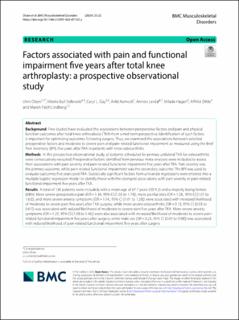Factors associated with pain and functional impairment five years after total knee arthroplasty: a prospective observational study
Olsen, Unni Solveig Johansen; Sellevold, Vibeke Bull; Gay, Caryl; Aamodt, Arild; Lerdal, Anners; Småstuen, Milada Cvancarova; Dihle, Alfhild; Lindberg, Maren Falch
Peer reviewed, Journal article
Published version
Permanent lenke
https://hdl.handle.net/11250/3112327Utgivelsesdato
2024Metadata
Vis full innførselSamlinger
Originalversjon
10.1186/s12891-023-07125-ySammendrag
Background Few studies have evaluated the associations between preoperative factors and pain and physical
function outcomes after total knee arthroplasty (TKA) from a mid-term perspective. Identification of such factors
is important for optimizing outcomes following surgery. Thus, we examined the associations between selected
preoperative factors and moderate to severe pain and pain-related functional impairment as measured using the Brief
Pain Inventory (BPI), five years after TKA in patients with knee osteoarthritis.
Methods In this prospective observational study, all patients scheduled for primary unilateral TKA for osteoarthritis
were consecutively recruited. Preoperative factors identified from previous meta-analyses were included to assess
their associations with pain severity and pain-related functional impairment five years after TKA. Pain severity was
the primary outcome, while pain-related functional impairment was the secondary outcome. The BPI was used to
evaluate outcomes five years post-TKA. Statistically significant factors from univariate regressions were entered into a
multiple logistic regression model to identify those with the strongest associations with pain severity or pain-related
functional impairment five years after TKA.
Results A total of 136 patients were included, with a mean age of 67.7 years (SD 9.2) and a majority being female
(68%). More severe preoperative pain (OR = 1.34, 95% CI [1.03 to 1.74]), more painful sites (OR = 1.28., 95% CI [1.01 to
1.63]), and more severe anxiety symptoms (OR = 1.14., 95% CI [1.01 to 1.28]) were associated with increased likelihood
of moderate to severe pain five years after TKA surgery, while more severe osteoarthritis (OR = 0.13, 95% CI [0.03 to
0.61]) was associated with reduced likelihood of moderate to severe pain five years after TKA. More severe anxiety
symptoms (OR = 1.25, 95% CI [1.08 to 1.46]) were also associated with increased likelihood of moderate to severe pain-
related functional impairment five years after surgery, while male sex (OR = 0.23, 95% CI [0.05 to 0.98]) was associated
with reduced likelihood of pain-related functional impairment five years after surgery.
Conclusion The identified preoperative factors should be included in larger prognostic studies evaluating the
associations between preoperative factors and mid-term pain severity and physical function outcomes after TKA
surgery.

